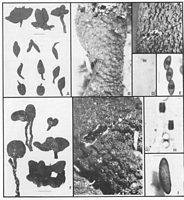|
 Xylaria anisopleura Xylaria anisopleura
SynonymsHypoxylon anisopleuron
BiostatusPresent in region - Indigenous. Non endemic
Images (click to enlarge)
Caption: Fig. 3 A-E Xylaria luteostromata var. macrospora A, Stromata (PDD 45394). B, C, Surface of
stromata (left: PDD 28412, right: PDD 45394). D, Ascal ring (Melzer's reagent, PDD 45394). E,
Ascospores with germ slits (Melzer's reagent, PDD |
Description: Stromata: Stromata spherical, or upright (taller than broad); stipitate; 10-15 mm tall; 4-5 mm diam.; perithecia not visible, or inconspicuous; ostioles lower than or more or less equal to stromatal surface; stromatal surface wrinkled; dark brown (brown vinaceous), or blackish; KOH-extractable pigments lacking; tissue below perithecia conspicuous, essentially homogeneous, white.
Perithecia: Perithecia more or less globose.
Asci: Stipe long with spores more or less confined to upper half of ascus; amyloid ring higher than broad.
Ascospores: Ascospores 22-27 µm long; 7-9 µm wide; brown; 0-septate; in side view inequilateral, flattened on one side, not curved; in face view elliptic; ends narrowly rounded. Germ slit straight, less than spore-length; on flattened side of spore. Perispore indehiscent in 10% KOH.
Article: Rogers, J.D.; Samuels, G.J. (1987) [1986]. Ascomycetes of New Zealand 8. Xylaria. New Zealand Journal of Botany 24(4): 615-650 (http://www.rsnz.org/publish/abstracts.php).
Description: Stromata consisting of a 1.5-2 cm diam. rosette of ± subglobose to conical to irregularly
shaped fertile portions, each fertile portion 10-15 mm diam.; the entire rosette with a 4-5
cm long, narrowed rooting stipe immersed in wood and perpendicular to the surface of the
decaying log; stipe not evident outside the wood. Mature stromata dark brown to black;
surface wrinkled, tuberculate with discoid ostiola, perithecia completely immersed. Fertile
portions and stipe with inconspicuous tomentum. Internal tissue of stroma solid, white.
Asci 250-260 µm total length x 7.5-10 µm, sporiferous portion (125-)144-180 µm,
cylindrical, apical ring J+, urn-shaped to cylindrical, (4.0-)4.5-6.0 µm wide x 5-8(-10) µm
high; 8-spored, ascospores uniseriate with overlapping ends. Ascospores (20-)22-27(-29) x
(6-)7-9(-10) µm, inequilateral with one side slightly concave to plane and the other side
round; elliptic in top view, ends pointed to papillate, transparent brown; slit diagonal, 8-9(-10) µm long.
Habitat: HABITAT: Known only from a single standing decorticated, dicotyledonous, dead tree.
Distribution: DISTRIBUTION: NORTH ISLAND: Northland.
Notes: NOTES: Ascospores from neither of the cited collections germinated on CMD at 20°C.
We have not seen an anamorph associated with mature stromata.
Xylaria anisopleura was originally described on material from French Guiana. Specimens
referable to this species have been seen from various sub-tropical and tropical areas of the
world. This species is represented from New Zealand by two collections. They differ from
most collections in having rooting stipes. The stipes were embedded in sawdust-like debris
which had originated from the activities of insect larvae in the tree host.
Xylaria anisopleura is related to X. polymorpha (Pers.:Fr.) Grev., differing in the smaller
size and moriform shape of stromata and the short, oblique to somewhat spiralling
ascospore germ slit. Type material [Cayenne, Leprieur 438 (K) (as Hypoxylon anisopleura
Mont.] has ascospores 27-34 x 8-10 µm, somewhat longer than those of our material.
|